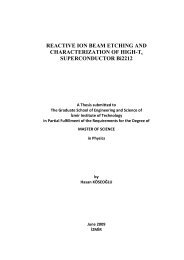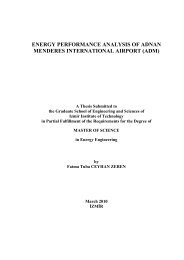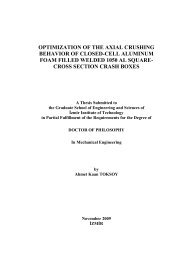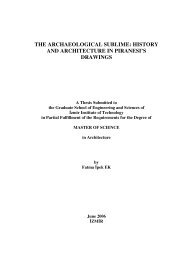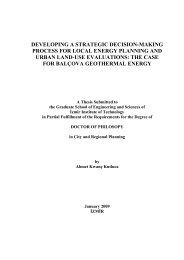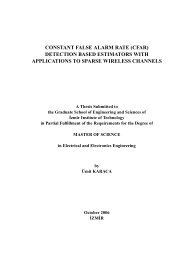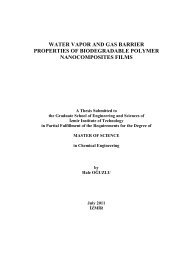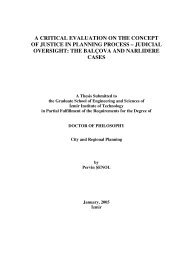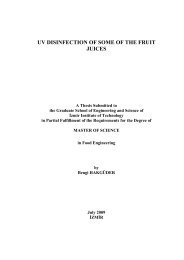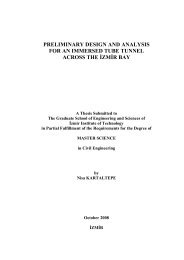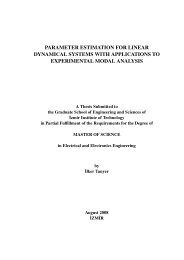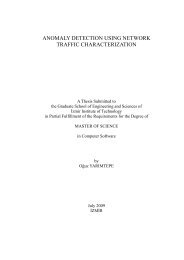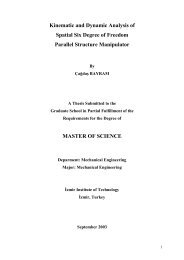the production of thymoquinone from thymol and carvacrol
the production of thymoquinone from thymol and carvacrol
the production of thymoquinone from thymol and carvacrol
Create successful ePaper yourself
Turn your PDF publications into a flip-book with our unique Google optimized e-Paper software.
5.4. Catalytic Monoterpene Oxidation with Hydrogen Peroxide ................ 28<br />
CHAPTER 6. EXPERIMENTAL................................................................................... 32<br />
6.1. Materials ............................................................................................... 32<br />
6.2. Methods ................................................................................................ 32<br />
6.2.1. Catalyst Preparations ...................................................................... 32<br />
6.2.1.1. Preparation <strong>of</strong> Lig<strong>and</strong> (H2Salpn) ........................................... 32<br />
6.2.1.2. Preparation <strong>of</strong> Metal Exchanged Zeolite Y ........................... 33<br />
6.2.1.3. Preparation <strong>of</strong> Encapsulated Complexes ............................... 33<br />
6.2.2. Catalyst Characterization................................................................. 33<br />
6.2.3. Catalytic Activity............................................................................. 34<br />
6.2.3.1. Decomposition <strong>of</strong> Hydrogen Peroxide<br />
6.2.3.2. Oxidation <strong>of</strong> Carvacrol <strong>and</strong> Thymol....................................... 34<br />
6.2.3.3. Heterogeneity Test.................................................................. 35<br />
CHAPTER 7. RESULTS AND DISCUSSION.............................................................. 37<br />
7.1. Catalyst Characterization...................................................................... 37<br />
7.1.1. Elemental Analysis by Inductively Coupled Plasma Analysis....... 37<br />
7.1.2. Scanning Electron Microscopy (SEM) Analysis ............................ 38<br />
7.1.3. X-Ray Diffraction (XRD) Analysis................................................ 40<br />
7.1.4. FTIR Spectroscopy Analysis .......................................................... 43<br />
7.1.5. Pore Volume <strong>and</strong> Surface Area Measurement................................ 47<br />
7.1.6. Thermal Analysis............................................................................ 47<br />
7.1.6.1. Differential Scanning Calorimetric Analysis <strong>of</strong> Lig<strong>and</strong>…….47<br />
7.1.6.2. Thermal Gravimetric Analysis (TGA)……........................... 48<br />
7.2. Catalytic Activities ............................................................................... 50<br />
7.2.1. Decomposition <strong>of</strong> Hydrogen Peroxide ........................................... 50<br />
7.2.2. Oxidation <strong>of</strong> Carvacrol ................................................................... 51<br />
7.2.3. Heterogeneity Test.......................................................................... 57<br />
7.2.4. Cr (salpn)-NaY Catalyst Recycle ................................................... 59<br />
7.3. Effect <strong>of</strong> Parameters for Carvacrol Oxidation Reactions with Selected<br />
Cr(Salpn)- NaY Catalyst ..................................................................... 60<br />
7.3.1. Effect <strong>of</strong> Catalyst Amount ............................................................. 61<br />
7.3.2. Effect <strong>of</strong> Temperature.................................................................... 62<br />
vii



